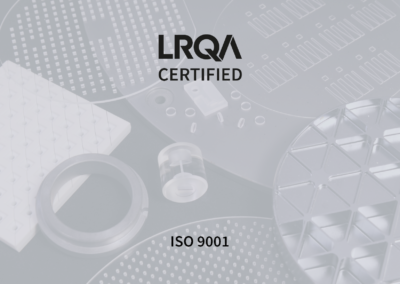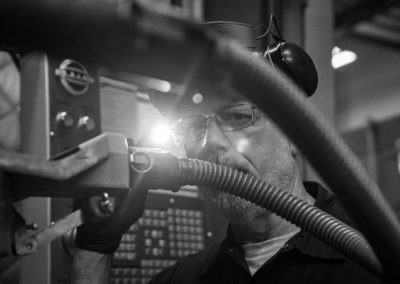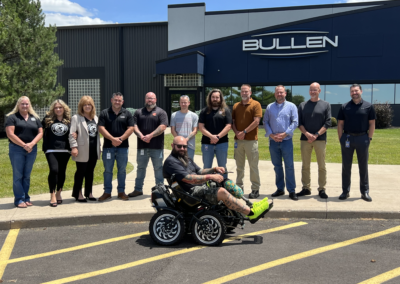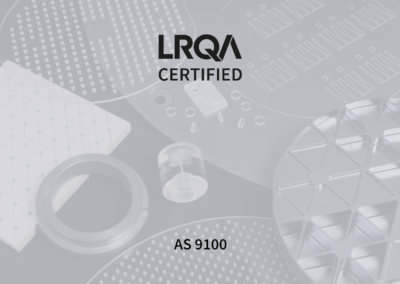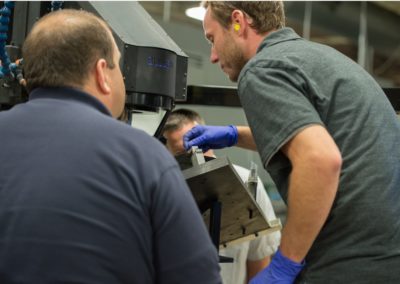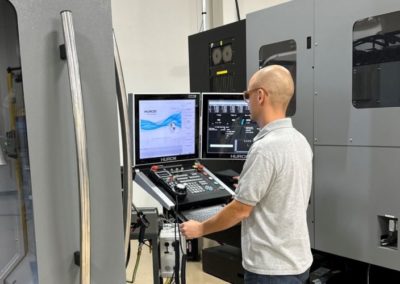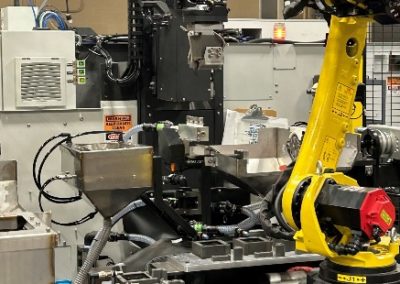Precision Machining: Custom Solutions for Complex Customer Challenges
At Bullen, we specialize in precision machining solutions, specifically in developing custom machines to manufacture high-quality parts for our customers. Our expertise lies in machining hard, brittle materials and producing complex features in a confidential environment.
Since few companies can meet the niche requirements we address, this article explores the history, needs, and future of precision machining and how our innovations shape custom machine development.
Understanding Precision Machining in Manufacturing
Traditionally, precision machines are not considered custom because custom machines tend to be less flexible. However, precision can vary by industry, and advanced needs have pushed us to refine our ultrasonic machining methods and invest in research and development. This has led to innovations like:
- MicroLucent® Laser Machining – Ideal for micron-level precision on transparent materials such as glass and quartz, allowing for:
- Round, rectangular, and irregular-shaped holes
- Slot machining and cavity machining
- Inside and outside diameter machining
- Blind cuts and cavities
- Robotic Cell Machining – Enhancing automation and precision through advanced robotic integration.
At Bullen, we work globally with industries including Aerospace, Automotive, Life Sciences, Medical, MEMs, Telecommunications, and Semiconductors. Our expertise in machining advanced ceramic components is made possible through our precision custom machines, often combined with traditional methods or robotics.
Why Custom Precision Machines Are Essential
Precision machines solve complex challenges that standard material removal processes cannot, including:
- Skills gaps in the workforce
- The need for higher precision and accuracy
- Limitations of traditional machining processes
These machines increase efficiency, precision, and functionality of traditional material removal processes. Built as custom machines, they are developed entirely around a part’s unique needs, ensuring the highest level of precision and efficiency as opposed to off-the-shelf machines that require part designs to fit existing capabilities or modified off-the-shelf machines that involve some behind-the-scenes engineering for part-specific adjustments.
A Brief History of Precision Machining
Early Innovations
- 300 B.C. – The Egyptians possibly used manual lathes to rotate parts against tools for material removal.
- The Lathe was further used and developed by the Romans, Vikings, and many other civilizations and industries before becoming widespread in the industrial revolution.
- Industrial Revolution – Custom machines emerged to improve accuracy and efficiency in manufacturing.
Servo Technology & High-Speed Machining
- 1860s-1930s – Servo technologies, which enable precise motion control, evolved for ship steering, radar control, and industrial automation.
- 1860s, a concept known as servo technologies came about, gaining more prominence in the 1920s and 1930s. It was used to refer to technology that automatically followed a specific command and used closed-loop feedback to precisely control motion, position, and speed. They typically consist of a servo motor, a controller, a feedback sensor (e.g., encoder), and a drive (amplifier) that regulates power. Servo technology may be a rotary or linear motor.
- Rotary motors (although not always called that) have been around for centuries and they use an encoder and the mechanical rotation of a ball screw, gear, or belt to determine position of the coil and part.
- Linear motors, which can be traced back to the 1840s and 1940s, are a bit like an unrolled rotary motor. However, linear motors keep the part stationary, and the coil moves along the part by using an electromagnetic field to direct linear force, reducing the need for mechanical components. Without the moving parts, linear motors gain better positioning accuracy and repeatability making them more precise, faster, and they last longer with less maintenance.
- Servo technology now spans electrical, hydraulic, and pneumatic systems, integrating AI-driven adaptive control and advanced sensor feedback to achieve sub-micron-level accuracy in industries like robotics, automation, and medical devices. Past principles and applications continue to evolve, solidifying servo technology’s role as the backbone of precision motion control.
- 1920s – High speed spindles that rotated parts during machining instead of manual labor were invented, but the industry was cautious about adopting them. They didn’t become more popular until the widespread use of High-Speed Machining (HSM) in the 1980s.
CNC & Digital Advancements
- 1940s-1950s – Computer Numerical Controlled (CNC) machines revolutionized manufacturing, enabling automated precision machining. CNCs are used to automatically operate lathes, mills, and other tools. The computer component controls the tool’s movement more precisely than manual and semi-automatic versions. So, we were able to machine more accurately, with less manpower, and produce parts at a higher rate.
- With the use of CNCs, a method of advanced control was created for the CNC machines. This allowed for dynamic adjustments to the machining process as it was already going based on real-time monitoring of the machine and part, allowing for more precision and uniformity.
- 1960s – An employee at General Motors invented easily programmable controllers known as Programmable Logic Controllers (PLCs) to replace hard-wired logic systems. PLCs are important to precision machining because they provide real-time control. So rather than having set, hard-wired logic, the controllers receive input from sensors and can process that information before sending output commands.
- 1970s – In 1972, Computer Aided Design (CAD) and Computer Aided Machining (CAM) were introduced and in 1976, 3D versions were available with CNC Machining. These programs allow engineers to create digital models of parts and give machines more precise instructions for their manufacturing. These design programs are used in alongside Computer Aided Engineering (CAE) to simulate performance under different conditions without having to machine the part in trial.
- 1980s – As previously noted, high speed machining began to be adopted more. This strategy of machining uses high-speed spindles and toolpath strategies to machine parts more quickly while minimizing heat generation and tool
- 1980s – Integrations between robotic arms and CNC machines began to improve material handling, loading, and tool changes.
Modern Advancements
- By the early 2000s, robots were used for automated quality inspection, improving repeatability in production.
- AI-driven robotics now optimize machining processes, adjusting in real-time based on sensor feedback.
- Hybrid machining systems combine robotic additive and subtractive processes (e.g., 3D printing and CNC milling) for increased design flexibility.
It’s great to know all this information, but why is it all relevant here? Well, some types of machines use methods like we’ve discussed above and are available off-the-shelf, so you design the part or product around what the machine can do. Other machines are sold as custom off-the-shelf machines by modifying standard machines for specific applications, but fully custom machines are designed from the ground up for a specific product. At Bullen, we utilize many of the previously mentioned technologies in various ways to create custom machines and solutions for each of our customers. While we don’t sell our custom machines, you can be assured that we explore every avenue to meet the unique needs of your part and business.
Future Trends in Precision Machining
The future of precision machining is being shaped by advancements in artificial intelligence, automation, digitalization, and sustainable manufacturing. Here are key trends that will drive innovation in the industry:
- Artificial Intelligence (AI) & Machine Learning
-
- Predictive maintenance will reduce downtime by analyzing machine data and detecting failures before they occur.
- Adaptive machining will enable real-time adjustments to cutting paths, speeds, and tooling based on live feedback.
- AI-driven process optimization will enhance efficiency by analyzing vast datasets and improving decision-making.
- Robotics & Automation
-
- Collaborative robots will assist human operators with material handling, assembly, and finishing processes.
- Autonomous machining cells will integrate robots, sensors, and AI for fully automated production.
- Hybrid manufacturing will combine additive (3D printing) and subtractive (CNC machining) methods to create complex part geometries.
-
- The Internet of Things (IoT) will connect machines, allowing real-time monitoring and predictive analytics.
- Digital twins will simulate machining processes before execution, reducing errors and material waste.
- Cloud-based CNC machining will enable remote monitoring and optimization of machining operations.
- Advanced Materials & Micromachining
-
- Demand for hard-to-machine materials like ceramics, composites, and titanium alloys will drive innovation in ultrasonic and laser machining.
- Micromachining and nanotechnology will expand, enabling ultra-small, highly precise components for medical devices and microelectronics.
- Sustainability & Green Manufacturing
-
- Eco-friendly coolant systems and minimal lubrication techniques will help reduce environmental impact.
- More companies will adopt energy-efficient machining processes to minimize waste and emissions.
- High-Speed & Ultra-Precision Machining
-
- Advancements in spindle technology will allow for faster cutting speeds without compromising accuracy.
- 5-axis and multi-axis machining will continue to evolve, enabling complex part production in fewer setups.
Precision machining is entering a new era of intelligence, automation, and sustainability. At Bullen, we are at the forefront of these innovations, integrating cutting-edge technology like our MicroLucent® laser machining into our available solutions. If you’re interested in learning more about how we can meet your unique machining needs, contact our team today.
At Bullen, we leverage advanced machining technologies to create custom solutions tailored to your specific challenges. While we don’t sell our machines, we develop them to optimize manufacturing processes and deliver superior results.
Let’s Talk Solutions
If you’re looking for a precision machining solution for your advanced ceramic material, we can help.
📩 Contact us via our contact form or email sales@bullentech.com to discuss your project.
